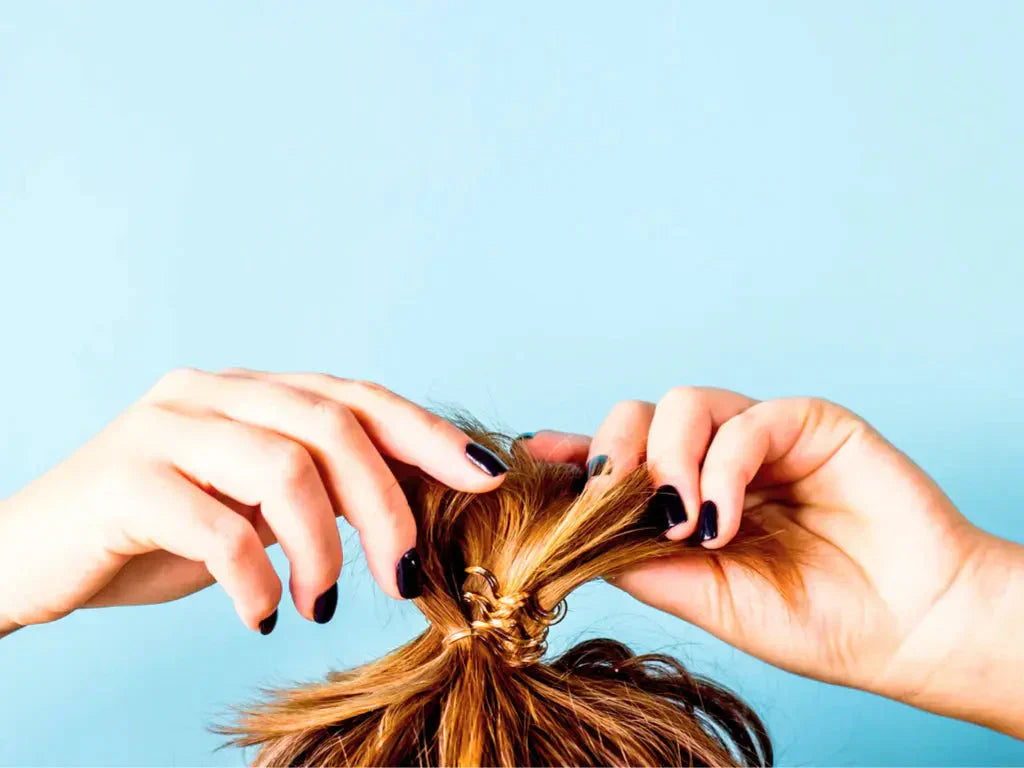The AI overview of the "Mom bun" is as follows:
A mom bun is a practical and popular hairstyle, often described as a messy bun, that is quick to style and keep hair out of the face (and away from a babies grabby hands).
It is characterized by its effortless and slightly relaxed look, making it a go-to choice for busy moms or anyone wanting a low-maintenance hairstyle.
Now, if you hit google images on "mom-bun" basically every mother to ever exist can find her photo when scrolling the pages upon pages of moms exhibiting the bun.
There are actually so many You-tube tutorials devoted to getting the bun perfected!

Steph Pase gives the ultimate messy mom-bun tutorial on You-Tube
I even found an article aimed at men titled: "10 Reasons Why You should LOVE your wife's MOM Bun". Not to ruin the article for you, but the #1 reason listed was 1. SHE PUT SOMEONE ELSE’S NEEDS, BEFORE HERSELF.
I kid you not, the blog opened by compared being a Mom with the fashionable office women men come in contact with...
"You see them...Those perfectly put together women in your office that are dressed to the nines. Their hair is done, their suits are tailored and their heels are high.
And then you come home and see her.
You know her…your wife..her hair in a bun...etc etc
I'm not going to link you to it.. Suffice to say this is NOT going to be the point I'm making.
What I'm going to tell you is, your mom-bun is partially responsible for ruining your hairline.
The Mom-BUN Is Ruining Your Hairline:
I'm so sorry, I really am- I know it's a hairstyle out of necessity postpartum. Your heart may actually be sinking with this revelation but the unfortunate truth is the mom-bun or just a tight ponytail can contribute to hairline thinning and even alopecia.
The Mom-Bun + Traction Alopecia:
Hair-loss and thinning that's caused by your hair repeatedly being pulled into the same hairstyle (like the mom-bun/ponytail) is called Traction Alopecia.
We could do a deep dive on traction alopecia, but to put it candidly: if you don't stop it - it can lead to permanent hair loss.
Having thick hair and a good hairline running in your family is irrelevant in these cases because this hair loss is a result of the hair being under tension constantly and continuously.
What can end up happening is the hair follicle can actually die off and then this thinning and receding becomes permanent.
The area where your hair was pulled most tightly (typically the hairline being pulled back) is typically the hair most susceptible to damage and hair loss.
Help! Can I reverse the hair loss?
Ways to Minimize the Mom-Bun Hair Thinning:
If your mom-bun addiction is real than at the LEAST take these tips to minimize the damage.
- Loosen it up: ( the less tight the bun is, the less pull and friction on the hairline).
- Use Gentle Hair Ties: 100% silk scrunchies are going to minimize the traction and pull on the hair.

- Mix-it-up: Different hairstyles avoid pressure on the exact same area of your scalp
- Avoid Chemicals and Heat Treatments: This will make hair more fragile and especially susceptible to breakage
-
Take Mini-Breaks: Take hair down frequently to give it a break from the tension of an up-do.
- Protect Your Hair At Night: Sleeping with a silk pillowcase will reduce friction on your hair which can prevent damage and breakage.
- Regularly Trim Your Hair: Avoid breakage and split ends with consistent trims.
In addition to the above, one of the best tips I got was to make sure I'm keeping my hair healthy from the inside. This means my daily hair vitamin, a strengthening shampoo and conditioner system, and always always using heat protection when styling.

Low-Traction Hairstyles to Try:
Ok, I didn't want to tell you to STOP doing your go-to hairstyle postpartum without giving you a few dermatologist approved suggestions.
These are some suggestions I've used with my two boys because I know the drill (keep hair out of their hands - they are probably the ultimate hair loss contributor).
- Braids: Ok a tight braid can actually cause some pull so keep it loose and you'll be good.
- Half up with a claw clip: claw clips cause significantly less tension when pulling hair off the face but remember to keep it still somewhat loose
- Short hair: I hate to say (because I have done a chop before and regretted it) but if you are really struggling and seeing thinning on the edges (and it's going to impact your hairline permanently) this might be a go to remedy for you for the time being.





